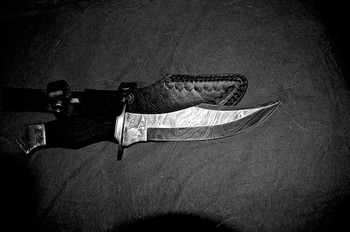Knife Safety For Kids
Mar 3rd 2022
One of the best gifts you can give an outdoorsy kid is a pocket knife. Pocket knives teach kids important values, such as trust, responsibility, and self-reliance. However, it is our job as parents to ensure they are equipped with the knowledge of how to handle a knife safely. So, here are some tips for introducing pocket knife safety to your kids.
Is Your Child Ready For A Knife?
Knife ownership is a tremendous responsibility for a child, but it can be a good way create a strong, trusting bond between you and your kids, as it demonstrates you can trust them and encourage them to be independent. One of the best low-risk ways to gauge the readiness of your children is by observing how they behave with other similar objects. If they can use a dull butter knife or school scissors with confidence and without injuries, they may be ready for their first pocket knives. Your children also must be capable of listening to and following instructions so you can teach them knife safety. However, they also need to be independent and have enough common sense to know how and when is the appropriate time to use their knives and how to care for their knives properly.
Choose The Right Knife
Your instinct may be to go with a utility knife. However, a knife with too many tools can be intimidating and difficult to manipulate for kids. So, a better option for a first pocket knife is a small folding knife that has no more than two blades. The knife should also have a short locking blade, with a smooth release, to avoid any accidents. The knife should fit comfortably in the palm of their closed hands but allow them to grasp the handle with all four fingers and not need to rest their thumbs on the blade. This encourages a safe and effective cutting technique.
Give A Knife Lesson
The first lesson you need to teach them is to identify the parts of their knives. This also provides an excellent opportunity to show them how to hold, open and close the knives as well. Of course, the parts they should know will depend on the model of knife you select, but, at a minimum, they should be able to identify the handle, blade, cutting edge, back, point, and nail slot. At this point, you could also teach them how to care for and maintain their knives. Emphasize to them that a sharp knife is safer than a dull knife and that moving parts need to be kept clean and well lubricated for the parts to work correctly.
Show Your Child How To Carry A Knife
You teach your children how to hold scissors when they walk, so you need to convey the same lesson when it comes to carrying their knives. The blade should always be closed when carrying or handing the knife to another person. When carrying the knives in their pockets, the blades must be closed with the tips pointing up, and they should be in the pocket on their "strong side”—that is, the same side of the hand that they write with. Many models of pocket knives have clips on the side which they can use to secure the knives in their pockets better. Emphasize they should never run with the knives open.
Opening and Closing Safety
Before opening a knife, make sure there is no one within arm's length. They can check this by holding the closed knives in their hands and extending their arms as far from their bodies as they can, then turning slowly in a circle. This is called a safety circle. If there is no one inside the safety circle, then it is safe to open their knives. To open, hold the handle of the knife in the weaker hand, with the back of the blade facing up and the hinge away from the body. Then they should use their strongest hands to open the blades. Pinch the spines of the blades between the forefinger and the thumb, slipping their nails into the nail slot for added security. Do not allow them to let go of the blades until they are fully open and clicked into place, as the blades can easily snap back and cut the fingers holding the handles. To close, use the same grasp and knife position as when opening, ensuring their fingers are fully clear of the blades as they shut. Ensure they use a firm grip on the blades and they do not let go until they are fully shut.
Safe Cutting Techniques
It is important to continually reiterate to your children that their pocket knives are tools and not toys and that they should only be used for practical purposes, like whittling, or cutting when hiking or camping. There are many different safe cutting techniques you can teach your children. But, one of the simplest techniques to begin with is the "straight arm" technique. Lock the knife arm to the side of the body and hold the blade at a 90-degree angle. Grasping the wood tightly, place the wood against the blade at the point closest to the handle and firmly pull back. This minimizes knife movement and reduces the risk of injury.
Final Thoughts
Different regions of the country have different laws concerning the minimum age for carrying a knife, and there also may be limitations on the size of the knife allowed. If you are unsure of your area’s knife laws, check the state knife laws online. Knives make a great gift for kids to teach them responsibility, confidence, and trust. But, before they can enjoy their pocket knife, it is paramount they learn the correct safety guidelines.

